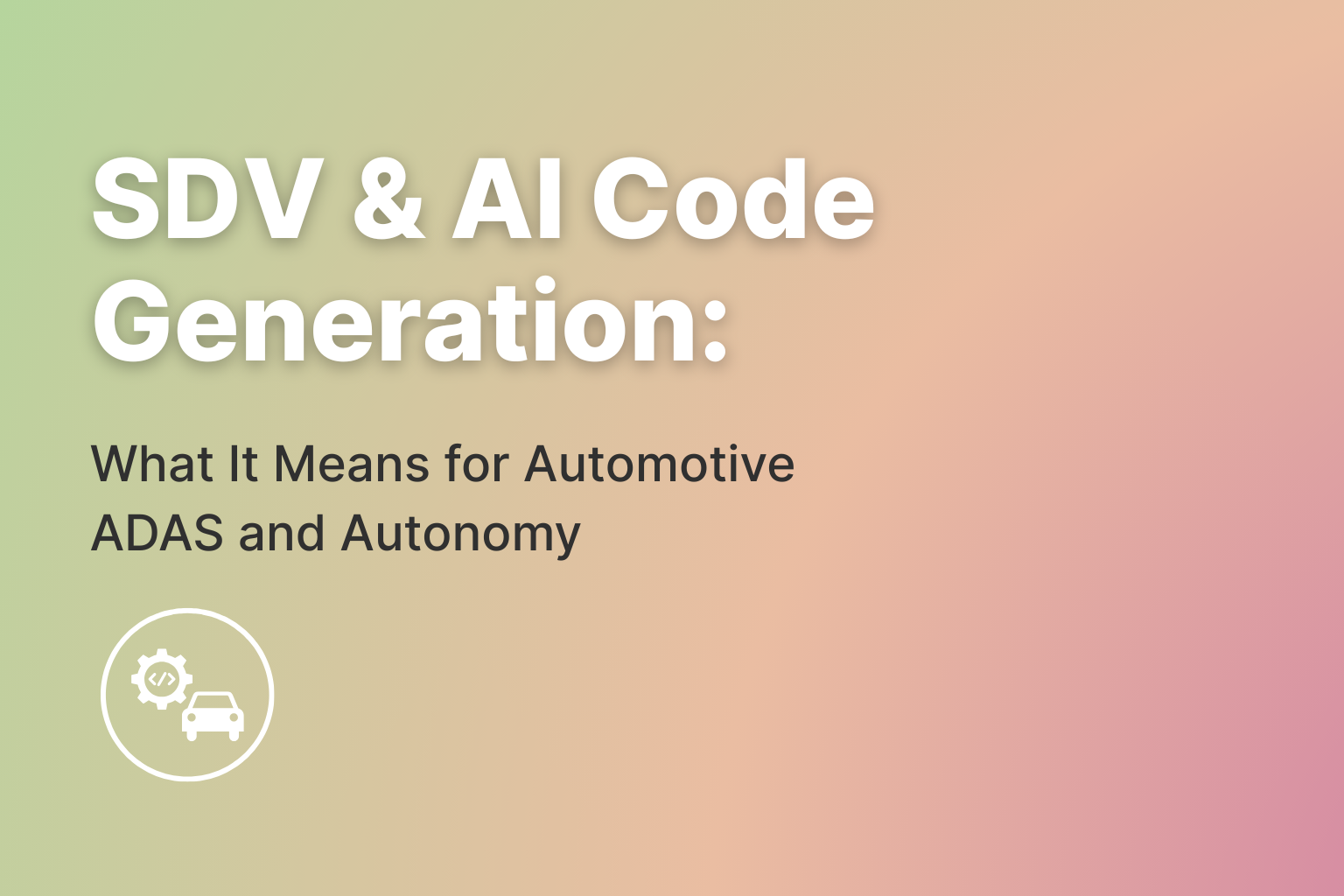Modern vehicles are no longer mechanical systems with isolated electronic modules. They are rolling high-performance computers, increasingly defined by software rather than hardware. This shift—known as the Software-Defined Vehicle (SDV) transformation—is reshaping how automakers design, update, and differentiate their products. And as OEMs accelerate toward ADAS, autonomy, and connected services, generative AI is emerging as a powerful accelerant for automotive software development.
But faster code generation also introduces new risks. Automotive systems must remain safe, deterministic, real-time, and efficient—requirements that raw AI-generated C/C++ rarely satisfies on its own. This creates a new mandate: combine AI coding tools with hardware-aware optimization and analysis to ensure SDV software remains as reliable as the industry demands.
This article breaks down the market trends, technical constraints, challenges, and opportunities—and explains how a hybrid workflow (AI + deep optimization) is becoming essential for ADAS and autonomous driving software.
1. The Software-Defined Vehicle (SDV) Era
The SDV fundamentally changes how vehicle features are delivered. Instead of dozens—or even more than 100—independent ECUs dedicated to single functions, automakers are consolidating electronics into centralized high-performance computers (HPCs) and zonal controllers. This architecture allows software to define most vehicle capabilities: ADAS behaviors, energy management, cabin features, connectivity, V2X, and more.
According to IBM, SDVs rely on a modular software stack and a service-oriented architecture that enables frequent over-the-air (OTA) updates, seamless feature rollouts, and continuous improvement of driver-assist algorithms. IBM research predicts that by 2030, 90% of vehicle innovation will be software-driven (📄source: IBM), while Deloitte reports that SDVs will represent at least 90% of new-vehicle sales by 2029 (📄source: Deloitte).
The market reflects this momentum: Grand View Research valued the SDV sector at $207.76 billion in 2024, projecting growth to $2,445.10 billion by 2033 (CAGR ~31.6%) (📄source: Grand View Research). And according to recent surveys, 79% of OEMs expect AI to play a central role in SDV development within the next few years (📄source: IBM).
This shift is propelled by:
- ECU consolidation into zonal and central compute architectures
- Massive expansion of software content (ADAS, connectivity, infotainment, energy management)
- OEMs positioning themselves as software companies
- The need for faster feature deployment cycles and continuous OTA updates
As the vehicle becomes more software-driven, embedded engineering teams face unprecedented pressure to deliver code that is both faster to develop and more optimized for constrained automotive hardware.
2. Embedded C/C++ at the Heart of Automotive Systems
Despite the rise of AI tools and cloud infrastructure, the core of automotive intelligence still runs on embedded C/C++—and will for many years (📄 source: IBM).
Critical systems such as:
- Powertrain and motor control
- Battery management systems (BMS)
- Vehicle control units (VCUs)
- ADAS sensor fusion pipelines
- Zonal and domain controllers
all depend on tightly optimized, real-time embedded code.
These systems must meet stringent requirements:
- Hard real-time deadlines (millisecond-level control cycles)
- Safety standards (ISO 26262, ASIL A-D) (👉🏻 Learn more about ISO 26262)
- Coding guidelines (MISRA, AUTOSAR C++14) (👉🏻 Learn more about MISRA)
- Constrained MCU/SoC resources
- Reliability across millions of vehicles
For example, an ADAS perception module fusing radar, lidar, and camera inputs cannot miss deadlines without degrading safety or driving performance. A 10–20% slowdown in execution time can increase CPU load, prevent real-time scheduling, or even require a hardware upgrade.
Generative AI promises value by accelerating boilerplate code, diagnostic routines, test benches, and prototype algorithms—but only if the final result is rigorously validated and optimized.
3. AI-Assisted Automotive Software Development
Generative AI models are increasingly capable of producing usable C/C++ for embedded systems. In automotive development, engineers are experimenting with AI to:
- Draft UDS/OBD-II diagnostic routines
- Create interface layers for sensors and actuators
- Prototype sensor fusion logic or perception algorithms
- Generate test harnesses and calibration helpers
- Document complex embedded functions
However, AI-generated code introduces risks:
- Safety-critical systems must comply with ISO 26262 (👉🏻 Read more about ISO 26262)
- ECUs must meet timing budgets, often with sub-millisecond control loops
- Code must respect memory constraints and remain highly predictable
- Generated code must adhere to MISRA and AUTOSAR guidelines
AI can speed up development, but it cannot be trusted blindly—especially in systems where errors can jeopardize passenger safety.
4. Key Challenges for AI-Generated Code in Automotive Embedded Systems
While generative AI accelerates early development, AI-produced C/C++ often fails to meet automotive MCU/SoC constraints:
- Real-Time Execution: Brake, steering, and perception pipelines operate under millisecond or microsecond deadlines. AI-generated loops can introduce jitter or exceed worst-case execution time.
- Safety & Reliability: Functional safety requires deterministic behavior; AI code can introduce hidden assumptions or mismanaged interrupts.
- Power & Efficiency: Battery management and domain controllers must run lean; inefficient code drains energy.
- OTA Update Constraints: Frequent SDV updates require strict versioning, regression testing, and performance validation.
- Resource Constraints: Limited RAM, flash, and cache make unoptimized AI code risky.
- Integration Complexity: Multi-domain, mixed-criticality software must integrate efficiently and safely.
As a result, automotive teams increasingly pair AI code generation with hardware-aware analysis and optimization tools.
5. Case Study: ADAS and Autonomous Driving Code
ADAS and autonomous driving require:
- High-speed sensor fusion
- Deterministic decision-making
- Real-time actuation
- Efficient memory handling
- Low latency and jitter
AI tools can help prototype sensor fusion or control-law algorithms. But the final implementation must be:
- Hardware-aware
- Fully optimized
- Predictable under load
- Validated for timing and memory
- Compliant with safety standards
This is why companies invest heavily in optimization pipelines for automotive-grade SoCs.
6. A Modern Workflow: AI Generation + Hardware-Aware Optimization
Hybrid workflow for automotive AI code:
- AI generates initial C/C++ – drivers, interfaces, prototypes
- Automated static analysis – MISRA, safety, memory checks
- Hardware profiling – execution time, stack/heap, latency, CPU load
- Automated optimization – loop transformations, memory layout, dead-code elimination (👉🏻 Learn more about automated optimization)
- Final validation – ISO 26262, AUTOSAR compliance
- Integration into SDV platform – OTA-ready, domain-compliant
AI accelerates development, but optimization ensures performance, safety, and resource efficiency.
Conclusion: The Hybrid Approach That Will Define the Future of Automotive Software
SDVs are here, bringing centralized computing, real-time pipelines, autonomy, and continuous OTA updates. Generative AI offers a productivity boost, but AI alone is not enough for automotive embedded systems.
The winning strategy is: AI-generated code + hardware-aware optimization + rigorous safety validation.
This ensures software—especially ADAS and autonomous driving code—remains:
- Real-time compliant
- Safety-certified
- Resource-efficient
- OTA-ready
- Optimized for the target ECU/MCU
Tools like beLow transform AI-generated C/C++ into production-ready embedded software.


.svg)





.svg)